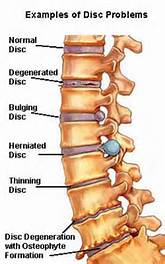Spinal degeneration is a broad term used to refer to changes to the spine. These changes may involve the intervertebral disc, vertebral body or changes to joints. Common features of spinal degeneration are disc height loss, disc bulging, facet joint changes, vertebral body changes and annular fissures.
With advancements in technology individuals presenting with back pain are more frequently referred for radiological investigations, such as CT and MRI scans, to provide a diagnosis. These scans can show signs of spinal degeneration and it is believed these changes are the cause of back pain. While these degenerative changes are found on scans it is important to correlate them to any symptoms and a physical assessment as they may not be the primary cause of back pain.
In a 2015 study it was reported that individuals who had never experienced back pain also demonstrated signs of spinal degeneration on imaging. The study indicated that 69% of 60 year olds showed signs of lumbar disc bulging and 50% had lumbar facet degeneration. The study also reported that 30% of individuals in their 20s had disc bulging but no symptoms of pain. Another study in 2015 found similar results in the cervical spine with spinal degenerative changes in individuals as young as 20 who had never experienced neck pain. Both studies found the prevalence of spinal degeneration increased with age however this did not correlate with pain. These results show that, even in asymptomatic individuals, at certain ages it can be more common to have features of spinal degeneration.
Spinal degeneration can be seen as a normal process of ageing, even from an early age, and it does not have to be the cause of pain. It is important that a physiotherapist or other health professional assesses your current pain and any radiological images to determine whether degenerative changes are the primary cause of your pain. Your physiotherapist will be able to discuss with you the most appropriate management such as conservative treatment or referral to other health professionals. Most degenerative changes can be effectively treated with conservative manual therapy methods.

